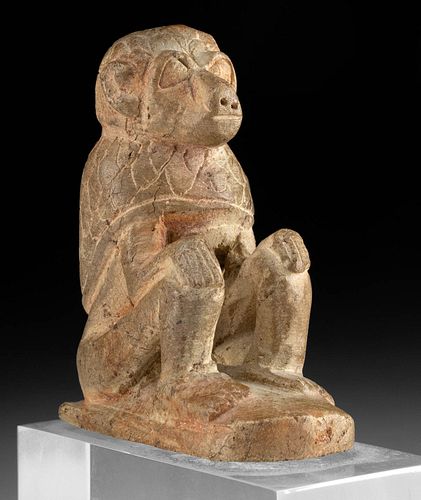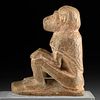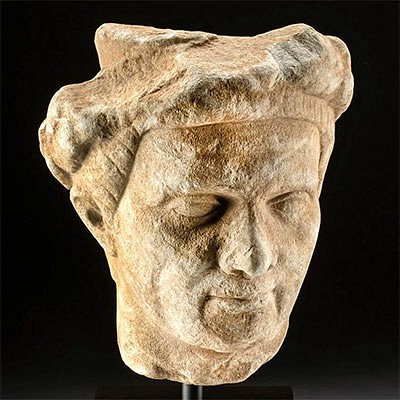Egyptian Glazed Steatite Cynocephalus Baboon / Thoth
Lot 5
About Seller
Artemis Fine Arts
686 S Taylor Ave, Ste 106
Louisville, CO 80027
United States
Selling antiquities, ancient and ethnographic art online since 1993, Artemis Gallery specializes in Classical Antiquities (Egyptian, Greek, Roman, Near Eastern), Asian, Pre-Columbian, African / Tribal / Oceanographic art. Our extensive inventory includes pottery, stone, metal, wood, glass and textil...Read more
Estimate:
$3,000 - $4,500
Absentee vs Live bid
Two ways to bid:
- Leave a max absentee bid and the platform will bid on your behalf up to your maximum bid during the live auction.
- Bid live during the auction and your bids will be submitted real-time to the auctioneer.
Bid Increments
| Price | Bid Increment |
|---|---|
| $0 | $25 |
| $300 | $50 |
| $1,000 | $100 |
| $2,000 | $250 |
| $5,000 | $500 |
| $10,000 | $1,000 |
| $20,000 | $2,500 |
| $50,000 | $5,000 |
| $100,000 | $10,000 |
| $200,000 | $20,000 |
About Auction
By Artemis Fine Arts
Jun 1, 2023
Set Reminder
2023-06-01 10:00:00
2023-06-01 10:00:00
America/New_York
Bidsquare
Bidsquare : Ancient | Asian | Ethno | Native American Art
https://www.bidsquare.com/auctions/artemis-gallery/ancient-asian-ethno-native-american-art-12905
Featuring classical antiquities, ancient, and ethnographic art from cultures encompassing the globe. Egyptian, Greek, Roman, Near Eastern, Asian, Pre-Columbian, Native American, African / Tribal, Oceanic, Spanish Colonial, Fossils, more! All legally acquired, legal to sell. Satisfaction guaranteed. Artemis Fine Arts info@artemisfinearts.com
Featuring classical antiquities, ancient, and ethnographic art from cultures encompassing the globe. Egyptian, Greek, Roman, Near Eastern, Asian, Pre-Columbian, Native American, African / Tribal, Oceanic, Spanish Colonial, Fossils, more! All legally acquired, legal to sell. Satisfaction guaranteed. Artemis Fine Arts info@artemisfinearts.com
- Lot Description
Egypt, Late Dynastic Period, 26th to 31st Dynasty, ca. 672 to 332 BCE. A delightful and quite impressive, glazed steatite sculpture of Thoth, the god of writing, mathematics, and myriad other intellectual pursuits. Typically depicted as an ibis-headed man, Thoth is shown here as a cynocephalus (dog-headed) baboon seated with forepaws resting on knees atop an integral plinth. The animal gazes forward, presenting an elongated snout, crescent-shaped eyes, and petite ears, all cloaked by a thick mane incised with a scale-like motif that drapes his head, shoulders, and back. Baboons warm their stomachs by sitting up, raising their paws, and facing the sun each morning, a behavior the Egyptians interpreted as solar worship. Baboon figures were included in burials to assist in the deceased’s rebirth, functioning as protective amulets and serving as eternal guardians of the dead. Size: 2" L x 1" W x 2.5" H (5.1 cm x 2.5 cm x 6.4 cm); 4" H (10.2 cm) on included custom stand.
Wild baboons had all but disappeared from around the Nile Valley by the Late Dynastic period, when this figure was made. Female baboons were placid enough to be domesticated and kept as pets, but they had to be imported at great cost from central Africa, making them exotic luxuries and conspicuous status symbols.
According to Egyptologists Erik Hornung and Betsy M. Bryan, "As primeval animals, baboons and green monkeys were prominent parts of the Egyptian cosmogony. The earliest gods are sometimes depicted with baboon heads. The baboon became an aspect of the sun god, Re . . . And of the moon god, Thoth-Khonsu. Thoth (Djehuty in ancient Egyptian) was the god of writing and knowledge, who was depicted in the form of two animals: the baboon (Papio cynocephalus) and the sacred Ibis (Threskiornis aethiopicus). In his baboon form Thoth was closely associated with the baboon god, Hedj-wer (the great white one) of the Early Dynastic period. By the end of the Old Kingdom (2686 - 2181 BCE) he was usually portrayed as an ibis-headed man, holding a scribal palette and pen or a notched palm leaf, performing some kind of act of recording or calculation." (Hornung, Erik and Betsy M. Bryan, eds. "The Quest for Immortality: Treasures of Ancient Egypt." National Gallery of Art, Washington, 2002, p. 200)
A Late Dynastic steatite sculpture of a baboon similar in style and scale to this example hammered for 12,500 GBP (equivalent to $17,255) at Christie's London as lot 33 on July 7th, 2021 (Live Auction 19875 "Antiquities").
Provenance: private Rancho Mirage, California, USA collection, by inheritance in 2020; ex-Dr. TDR Berreth, California, USA, acquired before 1982
All items legal to buy/sell under U.S. Statute covering cultural patrimony Code 2600, CHAPTER 14, and are guaranteed to be as described or your money back.
A Certificate of Authenticity will accompany all winning bids.
We ship worldwide and handle all shipping in-house for your convenience.
#179009Professional repair and restoration to back proper right corner of base. Some light surface wear with a few nicks and abrasions as well as light fissures to glaze. Otherwise, mostly intact with excellent presentation and nice remaining detail.Condition
- Shipping Info
-
All shipping is handled in-house for your convenience. Your invoice from Artemis Gallery will include shipping calculation instructions. If in doubt, please inquire BEFORE bidding for estimated shipping costs for individual items.
-
- Buyer's Premium



 EUR
EUR CAD
CAD AUD
AUD GBP
GBP MXN
MXN HKD
HKD CNY
CNY MYR
MYR SEK
SEK SGD
SGD CHF
CHF THB
THB














